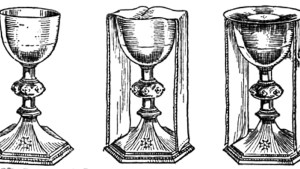While the Liturgy of the Word takes much inspiration from Jewish services that took place in synagogues during the 1st century, it is the Liturgy of the Eucharist that stands out as a unique development in the worship of God.
Liturgy of the Eucharist
The Liturgy of the Eucharist is seen as the second part of the Mass and is further subdivided into three primary movements, as described in the Catechism of the Catholic Church.
1
Offertory
The presentation of the offerings (the Offertory). Then, sometimes in procession, the bread and wine are brought to the altar; they will be offered by the priest in the name of Christ in the Eucharistic sacrifice in which they will become his body and blood. It is the very action of Christ at the Last Supper — “taking the bread and a cup.” “The Church alone offers this pure oblation to the Creator, when she offers what comes forth from his creation with thanksgiving.” The presentation of the offerings at the altar takes up the gesture of Melchizedek and commits the Creator’s gifts into the hands of Christ who, in his sacrifice, brings to perfection all human attempts to offer sacrifices.
From the very beginning Christians have brought, along with the bread and wine for the Eucharist, gifts to share with those in need. This custom of the collection, ever appropriate, is inspired by the example of Christ who became poor to make us rich.
CCC 1350-1351
2
Eucharistic Prayer
The anaphora: with the Eucharistic Prayer – the prayer of thanksgiving and consecration – we come to the heart and summit of the celebration:
In the preface, the Church gives thanks to the Father, through Christ, in the Holy Spirit, for all his works: creation, redemption, and sanctification. The whole community thus joins in the unending praise that the Church in heaven, the angels and all the saints, sing to the thrice-holy God.
CCC 1352-1353
In the institution narrative, the power of the words and the action of Christ, and the power of the Holy Spirit, make sacramentally present under the species of bread and wine Christ’s body and blood, his sacrifice offered on the cross once for all.
3
Communion
In the communion, preceded by the Lord’s prayer and the breaking of the bread, the faithful receive “the bread of heaven” and “the cup of salvation,” the body and blood of Christ who offered himself “for the life of the world”: Because this bread and wine have been made Eucharist (“eucharisted,” according to an ancient expression), “we call this food Eucharist, and no one may take part in it unless he believes that what we teach is true, has received baptism for the forgiveness of sins and new birth, and lives in keeping with what Christ taught.
CCC 1355



